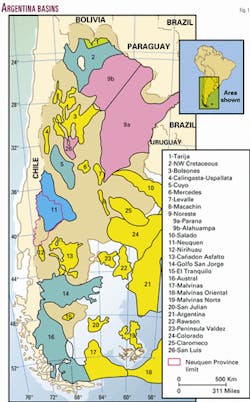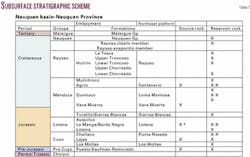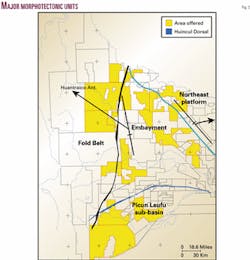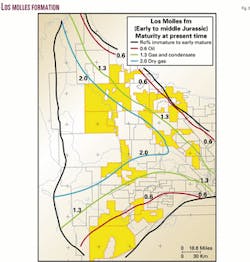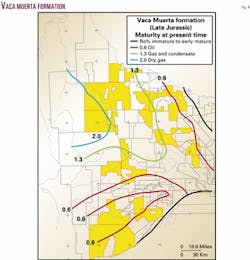Since last year, the government of the Neuquen Province (Argentina) has offered areas for exploration.
All areas are in Neuquen Province (Fig. 1). The former YPF SA previously explored all of the areas and relinquished most of them in 1996.1 Private companies later operated some others.
The bid system established under the Neuquen Plan is similar to the Exploration Plan implemented by the National Secretary of Energy.1 2
At the time of this writing, the following companies are the high bidders for exploration commitments on the blocks offered by the government:
- Chevron Corp. offered $16 million for the Las Tacanas area.
- Pioneer Natural Resources Inc. offered $18 million for the Cerro Vagon Area.
- TotalFinaElf offered $750,000 for the El Churqui area.
- Repsol-YPF SA offered $18.98 million for the Piedra Chenque area.
- Repsol-YPF offered $70 million for the La Banda area, topping Chevron's offer of $47 million.
The Covunco Norte area received no bids.
The government will offer the following areas: Corralera, Cortadera, El Mollar, Sauzalito, Mata Mora, Calandria Mora, El Corte, Bandurria, Totoral, Cañadon del Puma, Yerba Buena, La Invernada, and Coiron Amargo.
As of January 2001, the Neuquen basin had remaining reserves of 207 million cu m of oil and 399 billion cu m of gas.
From 1990 to 2000, production was 203 million cu m of oil and 194 billion cu m of gas.
From the beginning of exploration, 11,038 wells were drilled, of which 4,620 produced oil and gas.
Neuquen Province contains 70% of the oil and 92% of the gas production of the basin, and 62% of the oil reserves and 92% of the gas reserves.
At present, the Neuquen basin is the most prolific in Argentina with production obtained from clastic and carbonate reservoirs of Jurassic, Cretaceous, and Tertiary age. The proven source rocks correspond to the shales of the Jurassic Los Molles and Vaca Muerta formations, the shaly sections of the Cretaceous Agrio formation, and in the southern and southeast portion of the basin, lacustrine shales of the late Triassic-early Jurassic Puesto Kaufman formation (Table 1).
Hydrocarbons are accumulated in structural, combination, and stratigraphic traps. According to Hogg3 and confirmed with new data, in the basin about 22% of the stratigraphic traps hold 49% of the recoverable reserves while fields with structural traps constitute 52% and contain only 24% of the reserves. Most of the fields are located in the platform area.
The areas offered in Neuquen Province are located in sub-provinces with poorly defined limits (Fig. 2). The subprovinces are the fold belt, the embayment, and the northeastern platform. The southern limit of the three areas is the Huincul Dorsal, which separates the former from the Picun Leufu sub-basin.
Fold belt
The Yerba Buena, Totoral, and El Corte areas are located in both the fold belt and the Huincul Dorsal domain (Fig. 2).
These areas have the marine Lajas, the fluviatile Challaco, and the fluviatile and eolian Tordillo formations as reservoirs and the Los Molles and Vaca Muerta formations as source beds. These formations have production in Challaco, El Sauce, Cerro Bandera, Anticlinal Campamento, and other fields.
Some leads remained untested in the areas. To the west, the reservoir conditions become poor.
In the central part of the Yerba Buena area, a half-graben has been identified that contains a late Triassic-early Jurassic lacustrine facies section. The sequence is more than 3,000 m thick, laterally changing to alluvial fans and volcanic rocks that can replace the full sedimentary column.4 The lacustrine shales of Puesto Kaufman formation are the source rocks with TOC values between 2% and 8% and kerogen type I; the clastic facies have reservoir conditions, and seismic anomalies have been delineated.
The Millanquea x-1 well yielded 18 b/d of oil from the Lajas formation and tested noncommercial gas in the Pre-Cuyo (Puesto Kaufman formation) sediments.
The Cañadon El Puma and La Invernada areas were part of the Huantraico area, while the El Mollar, Cortadera, and Sauzalito areas corresponded to the Chihuidos block.
Before the relinquishments, San Jorge (presently Chevron) discovered Curamched and El Trapial fields on the Huantraico acreage. El Trapial field is a combination trap, situated on the south nose of the Chihuido de la Sierra Negra anticline.
As of March 2001, the cumulative oil production was 24 million cu m of oil and 2.2 billion cu m of gas reservoired in the Troncoso, Agrio, and Rayoso formations.
Since the beginning of exploitation, Curamched field has produced 35,000 cu m of oil and 203 million cu m of gas from the Avile sandstone (Agrio formation).
Regarding the Chihuidos block, the former Santa Fe Energy Resources Co. discovered Sierra Chata gas field. The field is a stratigraphic trap on the eastern flank of the Chihuidos anticline. This anticline is a NW-SE trending structure 100 km long and 50 km wide that crosses the block.
As of March 2001, Sierra Chata had produced 2.7 million cu m of condensate and 7.5 billion cu m of gas from sand zones of the Mulichinco formation. The Quintuco formation yielded noncommercial production.
The areas west of the discoveries, Cañadon El Puma, El Mollar, and Cortadera are partially located within the fold belt and west of the Chihuido anticline. They are characterized by elongated north-south trending anticlines with fair to poor reservoir conditions.
Towards the north, in the Chapua Este x-1 well, Kozlowski et al.5 postulated four units with good to very good generation conditions: the Vaca Muerta and Mulichinco formations and the lower and upper members of the Agrio formation. The oil accumulated in the Avile sandstones of the Agrio formation and the gas and condensate in the Mulichinco formation. In addition, Kozlowski et al.5 indicated that the most favorable petroleum systems along the belt are Agrio-Troncoso, upper section of the lower Agrio-Avile, and lower section of the lower Agrio-Mulichinco.
Due to the complex geology, the multiphase deformational history, and the scarce seismic and well data, the areas within and adjacent to the belt have limited exploration potential.
The fold belt has provided only 9% of the discovered oil reserves.6
Neuquen embayment
The La Invernada, Sauzalito, Bandurria, Coiron Amargo, and Mata Mora areas are located within the Neuquen embayment.
This subprovince occupies the central part of the basin. The west limit is the Chihuido anticline and the eastern limit the Charco Bayo-Entre Lomas-Señal Cerro Bayo trend. The south boundary is the north flank of the Huincul arch.
The Neuquen embayment contains the thickest Los Molles and Vaca Muerta source rock sections. Here is located the present basin center and the hydrocarbon kitchen.
The Los Molles (Type II to II-III kerogen) formation has TOC values of 1-5%, whereas the Vaca Muerta (Type I-II/II S kerogen) has TOC values of 3-8%. Hydrocarbons have migrated to all directions, and to the west the Vaca Muerta has generated gas and condensate in thermally post-mature areas.7
Parallel to the basin center axis are anticline closures that contain some of the larger oil and gas fields in the basin. These include Loma La Lata, Rio Neuquen, Aguada San Roque, Loma Las Yeguas, etc. The hydrocarbons are accumulated in the clastic reservoirs of the Mulichinco, Sierras Blancas, Lotena, Punta Rosada, and carbonate levels of the Quintuco formations.
In the Aguada San Roque and Loma Las Yeguas fields, the accumulations occur in igneous rocks that intrude the Quintuco formation. Aguada San Roque field contains hydrocarbons in the clastics of the Centenario formation.
Towards the northeast, structural closures are smaller but better defined at depth, where they control the accumulations at the level of Sierras Blancas and Punta Rosada clastic reservoirs.6
The Bandurria area was the former Añelo block. Several oil companies explored the area, and Perez Companc found oil in Aguada de la Arena field. The field is located to the east but outside of the present block and is an extension of Aguada La Pichana field. The hydrocarbons are accumulated in the Mulichinco formation.
As of April 2001, the cumulative production was 28,000 cu m of oil and 623,292 cu m of gas.
Within the present Bandurria block, Perez Companc drilled the Medano de la Amenaza well and recovered oil from the Tordillo-Sierras Blancas formation.
The Coiron Amargo area was part of the Loma de Mojon block. In this block, Pluspetrol found oil in the Sierras Blancas formation. The cumulative production totals 23,004 cu m of oil and 6.6 million cu m of gas. This field is adjacent to the north boundary of the Coiron Amargo block. The Vaca Muerta formation generated the hydrocarbons.
In addition, towards the east of the Coiron Amargo block, at the present Loma Campana Concession block, YPF found oil and gas in sandstones of the Sierras Blancas formation. The oil was generated in the Vaca Muerta formation.
The Mata Mora area was part of the Sierras Blancas area. YPF, Marathon, and Repsol explored this former area.
East of the block but in Rio Negro province, YPF drilled a well that yielded oil and gas from the Sierras Blancas formation.
As was demonstrated by the wells, the three areas have reservoir, source, and seal rocks although the occurrence of traps capable of contain hydrocarbons is uncertain.
Northeastern platform
In the Northeast Platform, most of the fields are structures aligned NW-SE, although a perpendicular and minor trend can be defined from SW-NE field distribution.8
The Los Molles and Vaca Muerta formations are the generative beds in this part of the basin. Both are in the oil window (Figs. 3 and 4), but there is not sufficient evidence that the reservoirs were charged by the Los Molles formation.
We postulate long migration pathways for the easternmost fields.
The main reservoirs in the Northeastern platform are the fluviatile clastics of the Punta Rosada formation, the fluvial-eolian clastics of the Tordillo-Sierras Blancas formation, the limestone of the Quintuco-Loma Montosa formation, clastics and calcareous limestones of the Mulichinco formation, and fluvial-deltaic sediments of the Centenario formation.
Towards the north, the oil is trapped in the Mulichinco, Avile, and Troncoso sandstones charged by hydrocarbons mainly generated in the Agrio formation.
Here, the traps have a mild-structural component, due to Tertiary compression or forced magmatic emplacement (Puesto Hernandez and Chihuido de la Sierra Negra fields).
The Calandria Mora area is within this subprovince. In the Calandria Mora area, YPF acquired a total of 498.95 km of seismic lines and drilled the Sierra Auca Mahuida x-1, Sierra Auca Mahuida x-2, and Peñas Blancas Chica x-1 wells.
The wells encountered rocks with reservoir characteristics and potential source beds. Total organic carbon (TOC) and vitrinite reflectance (Ro) maps indicate that the Los Molles, Vaca Muerta (Figs. 3 and 4), and Agrio formations are within the oil window.
It is possible that positive anomalies occur in the Calandria Mora area similar to those located in the adjacent Repsol's Volcan Auca Mahuida area. Here, Repsol-YPF found hydrocarbons in a four-way closed structure that covers 80 sq km. Basalts and andesites cover most of the acreage and vicinities; the basalts and andesite flows in the Auca Mahuida volcano are 800 m thick.
The hydrocarbons accumulated in sandstones of the Mulichinco formation in a compartmentalized structure.
A NW-SE oriented major fault system divides the structure into two anticlines, Auca Mahuida to the east and La Rebelde to the west.9
Through March 2001, the cumulative production was 59,274 cu m of oil and 54,394,484 cu m of gas. Nine wells produced hydrocarbons.
This prospect is likely to exist in other portions of this part of the basin.
Exploration needed
Most of the areas have favorable geological conditions to contain commercial quantities of hydrocarbons. However, detailed geophysical, geological and geochemical studies are necessary in all the areas to establish new prospects.
Acknowledgments
Thanks to Nelson Bruce with the Neu- quen government at Buenos Aires for his advice.
References
- Pucci, J.C., "Relinquishments in Argentina will boost exploration interest," OGJ, Sept. 30, 1996, p. 103.
- Pucci, J.C., "Potential assessed in Argentina's association contract areas," OGJ, June 20, 1994, p. 55.
- Hogg, S.L., "Geology and hydrocarbon potential of the Neuquen basin," Journal of Petroleum Geology, Vol. 16, No. 4, 1993, pp. 383-396.
- Legarreta, L., Laffitte, G., and Minitti, S., "Cuenca Neuquina: Múltiples posibilidades en las series Jur sico-Cret cicas del depocentro periandino," IV Congreso de Exploraci?n y Desarrollo de Hidrocarburos, Buenos Aires, Actas, pp. 145-175, 1999.
- Kozlowski, E., Cruz, C., and Sylwan, C., "Modelo exploratorio en la faja corrida de la Cuenca Neuquina, Argentina," Bol. Informaciones Petroleras, No. 55, 1998, pp 4-23.
- Uliana, M., and Legarreta, L., "Hydrocarbon Habitat in a Triassic-Cretaceous Sub-Andean setting, Neuquen Basin, Argentina," Journal of Petroleum Geology, Vol. 16, No. 4, 1993, pp. 397-420.
- Villar, H.J., Laffitte, G., and Legarreta, L., "The source rocks of the Mesozoic Petroleum Systems of Argentina: a comparative overview on their geochemistry, paleoenvironments and hydrocarbon generation patterns," IV Congreso de Exploraci?n y Desarrollo de Hidrocarburos, Buenos Aires, Actas, Vol. I, 1999, pp. 967-968.
- Veiga, R., Lara, M., and Bruveris, P., "Distribución de hidrocarburos sobre el margen externo en una cuenca de tras-arco. Ejemplos en la cuenca Neuquina, Argentina," Bol. Informaciones Petroleras, Buenos Aires, No. 60, 1999, pp 142-164.
- Zencich, S., "Descubrimiento de petróleo en la zona del volcán Auca Mahuida," Bol. Informaciones Petroleras, Buenos Aires, No. 62, 2000, pp. 18-29.

